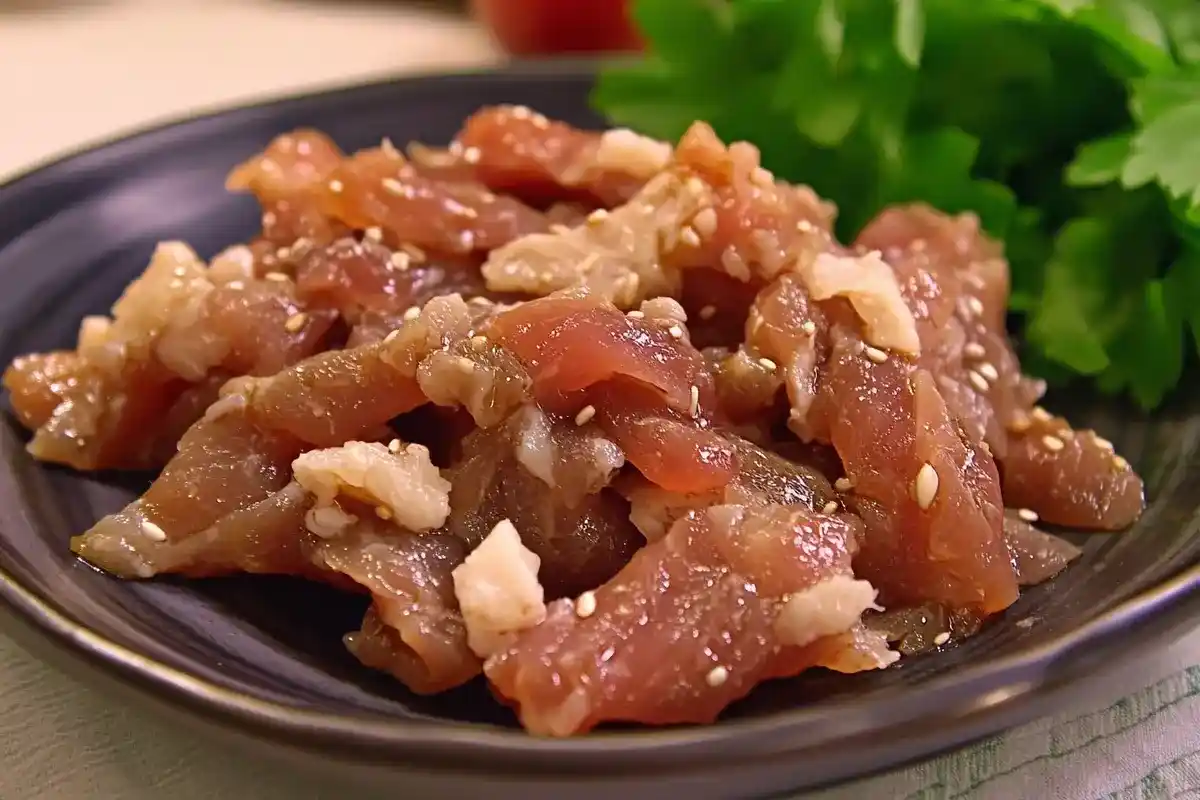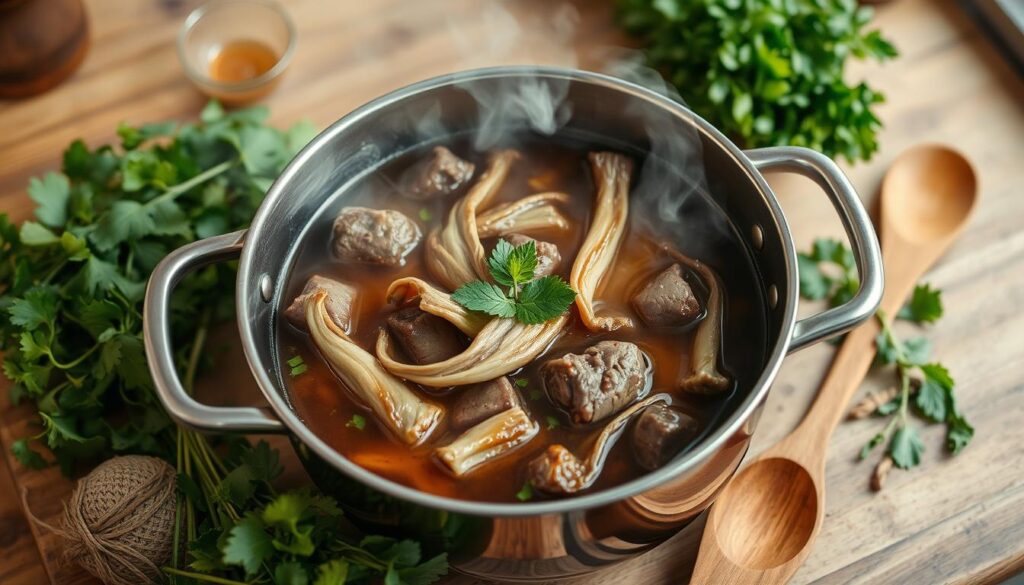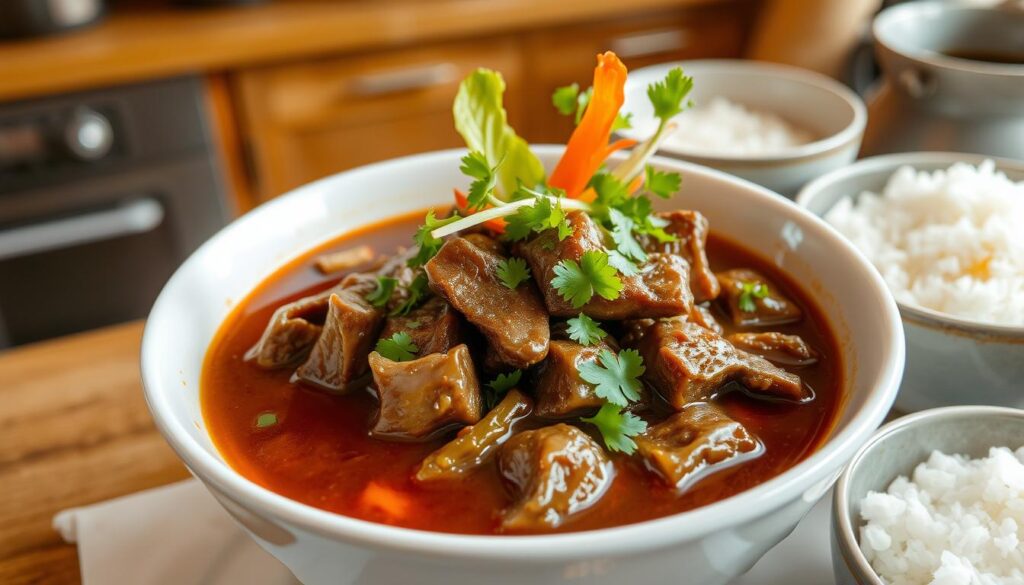introduction :
When you think about eating beef tendons, it’s key to look at their nutritional value and benefits. Beef tendons are packed with protein and collagen, which are good for your health. You might be curious about adding beef tendons to your diet and what they offer.
Beef is mostly protein and fat. A 3.5-ounce serving of broiled, ground beef has 217 calories. Lean, cooked beef has about 22-26% protein, making it a great protein source. You might be interested in the benefits of beef tendons, like their high protein and collagen. These can help with joint and skin health.
Thinking about beef tendon benefits, you should also consider the downsides. These include high fat content and possible allergic reactions. But, for those who can eat them, beef tendons might improve joint and skin health. The answer to whether beef tendons are good for you depends on their nutritional value and benefits.
Key Takeaways
- Beef tendons are a rich source of protein and collagen
- They can provide several health benefits, including improved joint health and skin health
- Beef tendons are low in fat, making them suitable for those watching their weight
- They are a natural and minimally processed alternative to commercial dog treats
- Eating beef tendons can be beneficial for overall health, but it’s essential to consider the possible drawbacks
- Beef tendons are easily digestible and can support healthy digestion
What Are Beef Tendons?
Beef tendons are a type of connective tissue found in cows. They have a gelatinous and tough texture. They are mostly made of protein, which is key for muscle growth, repair, and energy.
When we talk about the health benefits of beef tendons, it’s important to know what they’re made of. They have a special mix of protein, collagen, and minerals. This mix makes them a healthy choice.
Beef tendons are packed with protein, have low fat, and are rich in collagen. This makes them perfect for soups, stews, and braised dishes. The collagen in them helps keep joints healthy and prevents problems. The protein also helps build and repair muscles, which is great for active people and those who are growing.
- Rich in collagen, which is good for healthy joints and skin
- High in protein, important for muscle growth and repair
- Low in fat, making them a good snack for those watching their fat intake
- Contain minerals like calcium and phosphorous, which are good for strong bones and teeth
Eating beef tendons can bring many health benefits. They can improve joint health and support muscle growth. With their unique nutritional profile and versatility in cooking, they are a great addition to a healthy diet. Knowing what beef tendons are and what they offer can help you make smart choices for your meals.
Health Benefits of Eating Beef Tendons
Eating beef tendons offers many health benefits, thanks to their high beef tendon protein content. They are a great source of protein, helping to keep muscles strong and energy up. The beef tendon nutrition also includes lots of collagen, which is good for joints, mobility, and skin.
Some of the key benefits of consuming beef tendons include:
- High-quality protein to maintain muscle mass and energy levels
- Rich in collagen to support joint health and skin elasticity
- Low in fat, making them a suitable option for those watching their weight
- Naturally cleans teeth by reducing plaque and tartar buildup
Beef tendons are also easy to digest and can be a good choice instead of commercial treats. They can keep you entertained and help reduce boredom and stress. With their health benefits and beef tendon nutrition, it’s easy to see why they’re becoming a favorite for a healthy snack.
Adding beef tendons to your diet can greatly improve your health and wellbeing. Their high beef tendon protein content and collagen make them a great addition to a balanced diet.
Potential Drawbacks of Consuming Beef Tendons
Thinking about adding beef tendons to your meals? It’s good to know the downsides. Beef tendons can be tasty and healthy, but there are things to watch out for. One big issue is the high amount of saturated fat they contain. This might be a problem for those watching their fat intake.
Also, some people might have allergic reactions or sensitivities to beef tendons. These reactions can be mild or serious. To avoid allergic issues, make sure to cook beef tendons well. Start with small amounts to see how you react. If you want to try beef tendon recipes, look for ones that use less fat, like braising or stewing in low-fat broth.
- High saturated fat content
- Potential allergic reactions or sensitivities
- Importance of proper cooking and portion control
Being aware of these points can help you enjoy beef tendons’ health benefits while avoiding the downsides. Whether you’re looking to try new recipes or add variety to your meals, remember to put your health first.
How to Prepare Beef Tendons at Home
Preparing beef tendons at home can be a bit tricky. You might wonder how they compare to beef jerky in taste and nutrition. To find out if Is eating beef tendons good for you, you need to know the best cooking methods and recipes.
To cook beef tendons, you’ll need patience and the right tools. You’ll need a pressure cooker, sharp knives, and a cutting board. It’s also important to clean and trim the tendons properly for safety and tenderness. Rinse them under cold water, trim excess fat, and soak them before slicing.
Cooking Methods
There are two main ways to cook beef tendons: pressure cooking and traditional braising. Pressure cooking can make them tender in 15-20 minutes. Traditional braising uses spices like garlic and ginger for rich flavors.
Recipe Ideas
Beef tendons are great in many dishes, from soups to stir-fries. Here are some ideas to start with:
- Beef tendon soup with vegetables and noodles
- Stir-fried beef tendons with garlic and ginger
- Braised beef tendons in a rich demiglace sauce
Comparing beef tendons vs beef jerky, beef tendons are more versatile and nutritious. With the right cooking and recipes, you can enjoy their health benefits. So, is eating beef tendons good for you? Yes, if you prepare them right and eat them as part of a balanced diet.
| Cooking Method | Cooking Time | Result |
|---|---|---|
| Pressure Cooking | 15-20 minutes | Tender and flavorful tendons |
| Traditional Braising | 1-2 hours | Rich and deep flavors |
Comparing Beef Tendons to Other Cuts of Meat
Choosing the right cut of meat can be tricky. Beef tendons stand out because of their nutritional value. They are packed with protein, fat, and minerals. The beef tendon benefits include a lot of collagen, which is good for your joints and skin.
Beef tendons have more collagen than other cuts of meat. This is great for those who want to keep their joints healthy. They also have a lot of protein, which helps muscles repair and grow.
Beef tendons are versatile in cooking. You can use them in soups, stews, or braise them for a tender meal. Here’s a comparison of their nutritional content with other cuts:
| Cut of Meat | Protein Content | Collagen Content |
|---|---|---|
| Beef Tendons | 30g per 100g serving | High |
| Oxtail | 25g per 100g serving | Medium |
| Grass-fed Beef | 20g per 100g serving | Low |
In summary, beef tendons are a great choice for improving joint health and overall well-being. The health benefits of beef tendons make them a valuable part of a balanced diet.
Cultural Significance of Beef Tendons
Beef tendons have been a part of many cuisines for centuries. They are known for their high protein and collagen content. This makes them a favorite in many recipes.
In Asia, beef tendons are a key ingredient in Chinese, Japanese, and Korean dishes. They are often braised or stewed to make them tender and flavorful. In Europe, France and Italy use them in stews and pasta dishes. This shows how important beef tendons are in different cultures.
Some popular dishes that feature beef tendons include:
- Chinese beef tendon stew
- Japanese beef tendon soup
- Korean beef tendon stir-fry
These dishes show how versatile beef tendons are. They are also a good source of protein and collagen. But, it’s important to eat them in moderation because they can be high in fat and cholesterol.
In conclusion, beef tendons are not just a food item but also carry a rich cultural significance. They are nutritious and can be used in many dishes. Understanding their cultural and nutritional value helps us appreciate their importance in different cuisines and makes informed dietary choices.
| Cuisine | Traditional Dish | Preparation Method |
|---|---|---|
| Chinese | Beef Tendon Stew | Braising |
| Japanese | Beef Tendon Soup | Stewing |
| Korean | Beef Tendon Stir-Fry | Stir-frying |
Dietary Restrictions and Considerations
Adding beef tendons to your diet? You should think about any dietary limits you face. For those on keto or paleo diets, beef tendons are a protein-rich choice. But, pick your cooking methods wisely to stay true to your diet.
Cooking beef tendons can be a challenge. Yet, braising, slow cooking, or pressure cooking can make them tender and easy to digest. These methods soften the tendons, making them more enjoyable to eat.
If you’re lactose intolerant or have other dietary needs, watch out for beef tendon products. Some may have ingredients that could worsen your condition. Always read labels to ensure the product fits your dietary requirements.
- Keto diet: Beef tendons are a good protein source, but choose your cooking methods and ingredients carefully.
- Paleo diet: Beef tendons are a great protein option and can be cooked in ways that fit the paleo diet.
- Lactose intolerance: Be cautious of ingredients or preservatives that might trigger your intolerance.
| Dietary Restriction | Considerations |
|---|---|
| Keto diet | Be mindful of cooking methods and added ingredients |
| Paleo diet | Beef tendons are a good source of protein and can be cooked using paleo-friendly methods |
| Lactose intolerance | Be aware of added ingredients or preservatives that could exacerbate this condition |
Recommendations for Including Beef Tendons in Your Diet
Adding beef tendons to your diet needs careful thought about how much and how often. Beef tendon recipes can spice up your meals. Comparing them to beef jerky helps you choose better snacks.
It’s wise to eat beef tendons in moderation. They’re great in soups or stews. You can also use them to make homemade broth. Try different seasonings and spices to find your favorite flavor.
Here are some tips for adding beef tendons to your meals:
- Start with small portion sizes and adjust to your liking
- Experiment with different cooking methods, such as braising or slow cooking
- Combine beef tendons with other ingredients, such as vegetables or grains, to create a balanced meal
By following these tips and trying out different recipes, you can enjoy beef tendons’ health benefits. Always choose high-quality beef tendons. And don’t be afraid to get creative with your recipes.
| Beef Tendon Nutrition Facts | Per 100g Serving |
|---|---|
| Protein | 25g |
| Collagen | 10g |
| Fat | 5g |
Conclusion: Is Eating Beef Tendons Right for You?
Beef tendons can be a healthy choice for your diet, with many benefits. Whether they’re right for you depends on your taste and lifestyle. If you like their unique taste and want more protein and collagen, they might be good for you.
Personal Preference and Lifestyle
Deciding to eat beef tendons should match your taste, diet, and lifestyle. Some like their chewy texture, while others don’t. Think about how they fit into your meals and cooking plans.
Final Thoughts on Health Benefits
The health perks of beef tendons are promising, but results vary. If you have health concerns or special diets, talk to a doctor first. The choice to eat beef tendons is yours, based on what you prefer and your health.
FAQ
What are the health benefits of eating beef tendons?
Beef tendons are packed with protein and collagen. These nutrients help keep muscles strong, joints healthy, and skin elastic.
Are beef tendons high in fat and calories?
Yes, beef tendons have a lot of saturated fat. So, it’s wise to eat them in small amounts as part of a healthy diet.
How can I prepare beef tendons at home?
You can cook beef tendons by braising, stewing, or slow-cooking them. This makes them tender. There are many tasty ways to add beef tendons to your meals.
How do the nutritional values of beef tendons compare to other cuts of meat?
Beef tendons have more protein and collagen than other meats. But, they also have more saturated fat.
What is the cultural significance of beef tendons?
Beef tendons are a staple in many cuisines worldwide. They have a rich history and cultural importance in various societies.
Are there any dietary restrictions or considerations for consuming beef tendons?
People on keto or paleo diets should watch the fat and calories in beef tendons. Those with food allergies or sensitivities should be careful too.
How much beef tendons should I consume, and how often?
It’s best to eat beef tendons in moderation. The right amount and how often depends on your diet and personal preferences.



